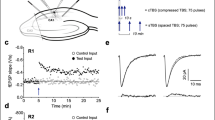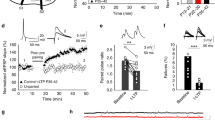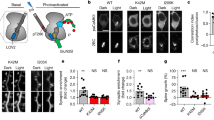Abstract
Long-term potentiation (LTP) is a form of synaptic plasticity that has been extensively studied as a putative mechanism underlying learning and memory. A late phase of LTP occurring 3–5 hours after stimulation and depending on transcription, protein synthesis and cyclic-AMP-dependent protein kinase (protein kinase A, or PKA) has been described1,2,3, but it is not known whether transcription of presynaptic and/or postsynaptic genes is required to support late-phase LTP. Here we show that late-phase LTP can be obtained in rat hippocampal CA1 mini-slices in which the cell bodies of presynaptic Schaffer collateral/commissural fibres are removed. Thus, transcription of presynaptic genes is not necessary to support maintenance of late-phase LTP. The AMPA (α-amino-3-hydroxy-5-methyl-4-isoxazole propionate) receptor is the predominant mediator of the ionotropic response to synaptically released glutamate in the hippocampus and it has been implicated in LTP maintenance. We find that synthesis of AMPA receptor subunits is increased three hours after LTP induction: this effect on the synthesis of the AMPA receptor is blocked by inhibitors of PKA and of transcription. Our results support the idea of a postsynaptic mechanism maintaining late-phase LTP, in which AMPA receptor synthesis is increased as a result of PKA-dependent gene transcription.
This is a preview of subscription content, access via your institution
Access options
Subscribe to this journal
Receive 51 print issues and online access
$199.00 per year
only $3.90 per issue
Buy this article
- Purchase on Springer Link
- Instant access to full article PDF
Prices may be subject to local taxes which are calculated during checkout





Similar content being viewed by others
References
Frey, U., Krug, M., Reymann, K. G. & Matthies, H. Anisomycin, an inhibitor of protein synthesis, blocks late phases of LTP phenomena in the hippocampal CA1 region in vitro . Brain Res. 452, 57–65 (1988).
Frey, U., Huang, Y.-Y. & Kandel, E. R. Effects of cAMP simulate a late stage of LTP in hippocampal CA1 neurons. Science 260, 1661–1664 (1993).
Nguyen, P. V., Abel, T. & Kandel, E. R. Requirement of a critical period of transcription for induction of a late-phase of LTP. Science 265, 1104–1107 (1994).
Nayak, A. S., Moore, C. I. & Browning, M. D. CAM kinase II phosphorylation of the presynaptic protein synapsin is persistently increased during expression of long-term potentiation. Proc. Natl Acad. Sci. USA 93, 15451–15456 (1996).
Frey, U., Krug, M., Brodemann, R., Reymann, K. & Matthies, H. Long-term potentiation induced in dendrites separated from rat's CA1 pyramidal somata does not establish a late phase. Neurosci. Lett. 97, 135–139 (1989).
Wenthold, R. J., Yokotani, N., Doi, K. & Wada, K. Immunochemical characterization of the non-NMDA glutamate receptor using subunit-specific antibodies. Evidence for a hetero-oligomeric structure in rat brain. J. Biol. Chem. 267, 501–507 (1992).
Maren, S., Tocco, G., Standley, S., Baudry, M. & Thompson, R. F. Postsynaptic factors in the expression of long-term potentiation (LTP): Increased glutamate receptor binding following LTP induction in vivo . Proc. Natl Acad. Sci. USA 90, 9654–9658 (1993).
Bartsch, D. et al. Aplysia CREB2 represses long-term facilitation: Relief of repression converts transient facilitation into long-term functional and structural change. Cell 83, 979–992 (1995).
Martin, K. C. & Kandel, E. R. Cell adhesion molecules, CREB, and the formation of new synaptic connections. Neuron 17, 567–570 (1996).
Davis, G. W., Schuster, C. M. & Goodmans, C. S. Genetic dissection of structural and functional components of synaptic plasticity. 3. CREB is necessary for presynaptic functional plasticity. Neuron 17, 669–679 (1996).
Liao, D., Hessler, N. A. & Malinow, R. Activation of postsynaptically silent synapses during pairing-induced LTP in CA1 region of hippocampal slice. Nature 375, 400–404 (1995).
Voronin, L. L., Volgushev, M., Chistiakova, M., Kuhnt, U. & Singer, W. Involvement of silent synapses in the induction of long-term potentiation and long-term depression in neocortical and hippocampal neurons. Neuroscience 74, 323–330 (1996).
Isaac, J. T. R., Crair, M. C., Nicoll, R. A. & Malenka, R. C. Silent synapses during development of thalamocortical inputs. Neuron 18, 269–280 (1997).
Barria, A., Muller, D., Derkach, V., Griffith, L. C. & Soderling, T. R. Regulatory phosphorylation of AMPA-type glutamate receptors by CaM-KII during long-term potentiation. Science 276, 2042–2045 (1997).
Parfitt, K. D., Doze, V. A., Madison, D. V. & Browning, M. D. Isoproterenol increases the phosphorylation of the synapsins and increases synaptic transmission in dentate gyrus but not area CA1 of the hippocampus. Hippocampus 2, 59–64 (1992).
Haycock, J. W., Browning, M. D. & Greengard, P. Cholinergic regulation of protein phosphorylation in bovine adrenal chromaffin cells. Proc. Natl Acad. Sci. USA 85, 1677–1681 (1988).
Stone, L. M., Browning, M. D. & Finger, T. E. Differential distribution of the synapsins in the rat olfactory bulb. J. Neurosci. 14, 301–309 (1994).
Snell, L. D. et al. Regional and subunit specific changes in NMDA receptor mRNA and immunoreactivity in mouse brain following chronic ethanol ingestion. Mol. Brain Res. 40, 71–78 (1996).
Author information
Authors and Affiliations
Rights and permissions
About this article
Cite this article
Nayak, A., Zastrow, D., Lickteig, R. et al. Maintenance of late-phase LTP is accompanied by PKA-dependent increase in AMPA receptor synthesis. Nature 394, 680–683 (1998). https://doi.org/10.1038/29305
Received:
Accepted:
Issue Date:
DOI: https://doi.org/10.1038/29305
This article is cited by
-
Cell-type-specific asynchronous modulation of PKA by dopamine in learning
Nature (2021)
-
Intracellular oligomeric amyloid-beta rapidly regulates GluA1 subunit of AMPA receptor in the hippocampus
Scientific Reports (2015)
-
Dorsal hippocampal brain receptor complexes linked to the protein synthesis-dependent late phase (LTP) in the rat
Brain Structure and Function (2015)
-
Reduced neuronal signaling in the ageing apolipoprotein-E4 targeted replacement female mice
Scientific Reports (2014)
-
Delayed Noradrenergic Activation in the Dorsal Hippocampus Promotes the Long-Term Persistence of Extinguished Fear
Neuropsychopharmacology (2014)
Comments
By submitting a comment you agree to abide by our Terms and Community Guidelines. If you find something abusive or that does not comply with our terms or guidelines please flag it as inappropriate.



